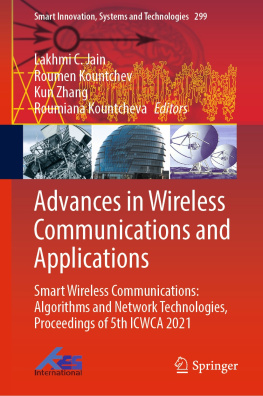Wireless Device-to-Device Communications and Networks
Covering the fundamental theory together with the state of the art in research and development, this practical guide provides the techniques needed to design, analyze, and optimize device-to-device (D2D) communications in wireless networking.
With an ever-increasing demand for higher-data-rate wireless access, D2D communication is set to become a key feature supported by next-generation cellular networks. This book introduces D2D-based wireless communications from the physical-, MAC-, network-, and application-layer perspectives, providing all the key background information before moving on to discuss real-world applications as well as potential future developments. Key topics are discussed in detail, such as dynamic resource sharing (e.g., of spectrum and power) between cellular and ad-hoc D2D communications to accommodate larger volumes of traffic and provide better service to users. Readers will understand the practical challenges of resource management, optimization, security, standardization, and network topology, and learn how the design principles are applied in practice.
Lingyang Song is Professor of Wireless Communications at Peking University, China, where he has worked since 2009. His main research interests include cooperative and cognitive communications, physical-layer security, smart grids, and mobile social networks. He is the recipient of the 2012 IEEE Asia Pacific Young Researcher Award and the 2012 NSFC Outstanding Young Investigator Award.
Dusit Niyato is an Associate Professor in the School of Computer Engineering at the Nanyang Technological University (NTU), Singapore. He has won international awards including the IEEE Communications Society Asia Pacific Young Researcher Award and the 2011 IEEE Communications Society Fred W. Ellersick Prize. He works in various research areas, including cognitive radio, mobile cloud computing, machine-to-machine communications, performance analysis, and optimization of wireless networks.
Zhu Han is an Associate Professor in the Electrical and Computer Engineering Department at the University of Houston, Texas. He received an NSF CAREER award in 2010 and the IEEE Fred W. Ellersick Prize in 2011. He co-authored papers that won the best paper award at the IEEE International Conference on Communications 2009, the 7th International Symposium on Modeling and Optimization in Mobile, Ad Hoc, and Wireless Networks (WiOpt09), and the IEEE Wireless Communication and Networking Conference, 2012. He is an IEEE Fellow.
Ekram Hossain is a Professor in the Department of Electrical and Computer Engineering at the University of Manitoba, Canada, where his current research interests include the design, analysis, and optimization of wireless/mobile communications networks, cognitive radio systems, and network economics. He has received several awards, including the 2010 and the 2014 University of Manitoba Merit Award (for Research and Scholarly Activities), the 2011 IEEE Communications Society Fred W. Ellersick Prize Paper Award, and the IEEE Wireless Communications and Networking Conference 2012 Best Paper Award.
Wireless Device-to-Device Communications and Networks
LINGYANG SONG
Peking University, Beijing
DUSIT NIYATO
Nanyang Technological University, Singapore
ZHU HAN
University of Houston, Texas
EKRAM HOSSAIN
University of Manitoba, Canada

University Printing House, Cambridge CB2 8BS, United Kingdom
Cambridge University Press is part of the University of Cambridge.
It furthers the Universitys mission by disseminating knowledge in the pursuit of education, learning and research at the highest international levels of excellence.
www.cambridge.org
Information on this title: www.cambridge.org/9781107063570
Cambridge University Press 2015
This publication is in copyright. Subject to statutory exception and to the provisions of relevant collective licensing agreements, no reproduction of any part may take place without the written permission of Cambridge University Press.
First published 2015
Printed in the United Kingdom by TJ International Ltd., Padstow, Cornwall
A catalogue record for this publication is available from the British Library
Library of Congress Cataloguing in Publication data
Song, Lingyang.
Wireless device-to-device communications and networks / Lingyang Song,
Peking University, Beijing, Dusit Niyato, Nanyang Technical University, Singapore,
Zhu Han, University of Houston, Texas, Ekram Hossain, University of Manitoba, Canada.
pages cm
Includes bibliographical references and index.
ISBN 978-1-107-06357-0
1. Machine-to-machine communications. I. Title.
TK5105.67.S66 2015
004.6 1dc23
2014035056
ISBN 978-1-107-06357-0 Hardback
Cambridge University Press has no responsibility for the persistence or accuracy of URLs for external or third-party internet websites referred to in this publication, and does not guarantee that any content on such websites is, or will remain, accurate or appropriate.
Dedications
To my family, Zhu Han
To Suprova Hossain and Nirvoy Lalon, Ekram Hossain
Contents
Preface
Now that more and more new mobile multimedia-rich services are becoming available to mobile users, there is an ever-increasing demand for higher-data-rate wireless access. Therefore, new wireless technologies such as Long Term Evolution Advanced (LTE-A) and WiMAX have been introduced, which are capable of providing high-speed, large-capacity, and guaranteed-quality-of-service (QoS) mobile services. Apart from the new technologies, new techniques such as small-cell networks and heterogeneous networks (HetNets) have also been developed, which are able to improve network capacity by reducing cell size and effectively controlling the interference. However, all these attempts still rely on a centralized network topology, which entails mobile devices communicating with a base station or access point. Such a centralized network topology is inherently limited by the capabilities of the base station and access point, which could be congested due to the presence of a large number of communicating devices. Also, the base station and access point might not have complete information about transmission parameters among devices, which is required in order to achieve the optimal network performance. To mitigate this problem, the concept of device-to-device (D2D) communications has been introduced to allow local peer-to-peer transmission among mobile devices offloading traffic from the base station and access point. Also, it is crucial to increase the wireless network capacity to accommodate the bandwidth-consuming mobile applications and services. Device-to-device communications is a promising concept to improve user experience and resource utilization in cellular networks, operating in both licensed and unlicensed spectrum bands.













